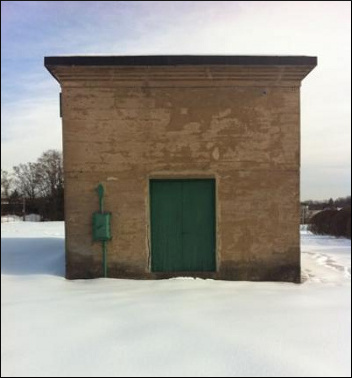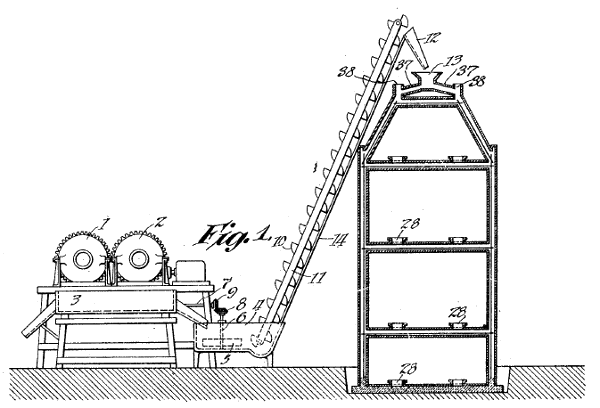People Who Live in Concrete Houses...
June 30, 2011
...Can always throw stones.
Concrete is a marvelous material that's used in so much of modern construction. Every house I've lived in has had either a seamless (
cast; or, in builder's parlance, "poured") concrete foundation or a
concrete block foundation. Each of these were fabricated on a "
footing" that was also made from concrete.
The houses themselves used
wood frame construction, but there are many commercial buildings that are wholly cast from concrete. I still remember watching as a child the
pouring of the concrete walls during construction of the
Munson-Williams-Proctor Museum of Art (
Utica, New York), a building designed by the
architect,
Philip Johnson.
As I wrote in a
previous article (Greatest Material Events of All Time, April 10, 2007), members of the Minerals, Metals & Materials Society (or
The Materials Society (TMS), as it's usually called), declared that concrete was the sixth most important material in history.[1] Modern concrete, which was invented by
John Smeaton in 1775, came in ahead of many high-tech materials, such as
carbon nanotubes, which ranked thirty-sixth.[2]
It isn't surprising that the prolific American inventor,
Thomas Edison, was interested in concrete. As I mentioned in a
previous article (Edison's Iron Mine, September 20, 2010), one byproduct of Edison's ill-fated
iron mining venture in the late
nineteenth century was pulverized stone that was sold to local construction companies as a concrete additive. We've been reminded in a recent presentation that Edison was the inventor of the cast concrete dwelling.[3-4]
Matt Burgermaster, an assistant professor at the
New Jersey Institute of Technology, presented a poster about this at the
64th Annual Meeting of the Society of Architectural Historians New Orleans, Louisiana April 13-17, 2011. His poster, in the session on Materials, Matter, Materiality, and Architecture, was entitled, "Edison's 'Single-Pour System': Inventing Seamless Architecture."[3]

Prototype of an Edison concrete house, still standing after a hundred years.
This house is located at the Thomas Edison National Historic Park, West Orange, New Jersey.
Yes, we do get snow in New Jersey.
Photo via NJIT [4]
The photograph above depicts a
prototype of a concrete house that Edison used as a proof-of-concept of his idea. This house, still standing after a hundred years, was fabricated on the grounds of Edison's New Jersey factory.[4] The factory site is now the
Thomas Edison National Historic Park,
West Orange, New Jersey. Other houses of this type still exist in towns around the Edison factory.
Edison's motivation for this construction technique was his desire to provide mass-produced, low-cost housing for the
working class that staffed his factories. In this quest, Edison was about thirty years ahead of
William Levitt, although Levitt actually built
Levittown, and Edison just built a few examples. Says Burgermaster,
"Edison's one-of-a-kind system was patented for the purpose of building a single, repeatable structure without any parts, with a single act of construction... and, remarkably, 100 years later, many of these houses remain standing."[4]
As can be seen in the figure, below, from Edison's 1919 patent, a house-sized
mold is used with sufficient air venting to allow a uniform flow of concrete from the top of the house to the bottom. All parts of the house, including the foundation, walls, floors and ceilings were formed in a single operation. The resulting house is seamless, and with proper choice of materials, perhaps cladding in layers, this same process might be used to make
energy-efficient houses. You just pour your
insulating materials in a layered structure.

Figure one of US Patent No. 1,326,854, 'Apparatus For The Production Of Concrete Structures.' [5]
As I wrote at the beginning of this article, modern architects are using the principle contained in Edison's patent; but, as Burgermaster states, few know of Edison's work. Most of them believe that this idea originally came from the
European avant-garde architects, such as
Le Corbusier and the
Bauhaus School. The ideas were developed independently. It's unlikely that the architects read Edison's corner of the patent literature.
References:
- Great Materials Moments, Science, vol. 315, no. 5819 (23 March 2007), p. 1643.
- Full list on the TMS web site.
- Matt Burgermaster, "Edison's ‘Single-Pour System': Inventing Seamless Architecture," 64th Annual Meeting of the Society of Architectural Historians, New Orleans, Louisiana, April 13-17, 2011.
- Sheryl Weinstein, "Thomas Edison also invented the concrete house, says NJIT researcher," New Jersey Institute of Technology Press Release, June 1, 2011.
- Thomas A. Edison, "Apparatus For The Production Of Concrete Structures," US Patent No. 1,326,854, Dec 30, 1919.
Permanent Link to this article
Linked Keywords: Concrete; casting; concrete block; footing; wood frame construction; pouring concrete walls; Munson-Williams-Proctor Museum of Art; Utica, New York; architect; Philip Johnson; The Materials Society; TMS; John Smeaton; carbon nanotube; Thomas Edison; iron mining; nineteenth century; New Jersey Institute of Technology; 64th Annual Meeting of the Society of Architectural Historians; New Orleans, Louisiana; NJIT; prototype; Thomas Edison National Historic Park; West Orange, New Jersey; working class; William Levitt; Levittown; molding; mold; energy conservation; energy-efficient; building insulation; insulating materials; US Patent No. 1,326,854; European; avant-garde; Le Corbusier; Bauhaus School.